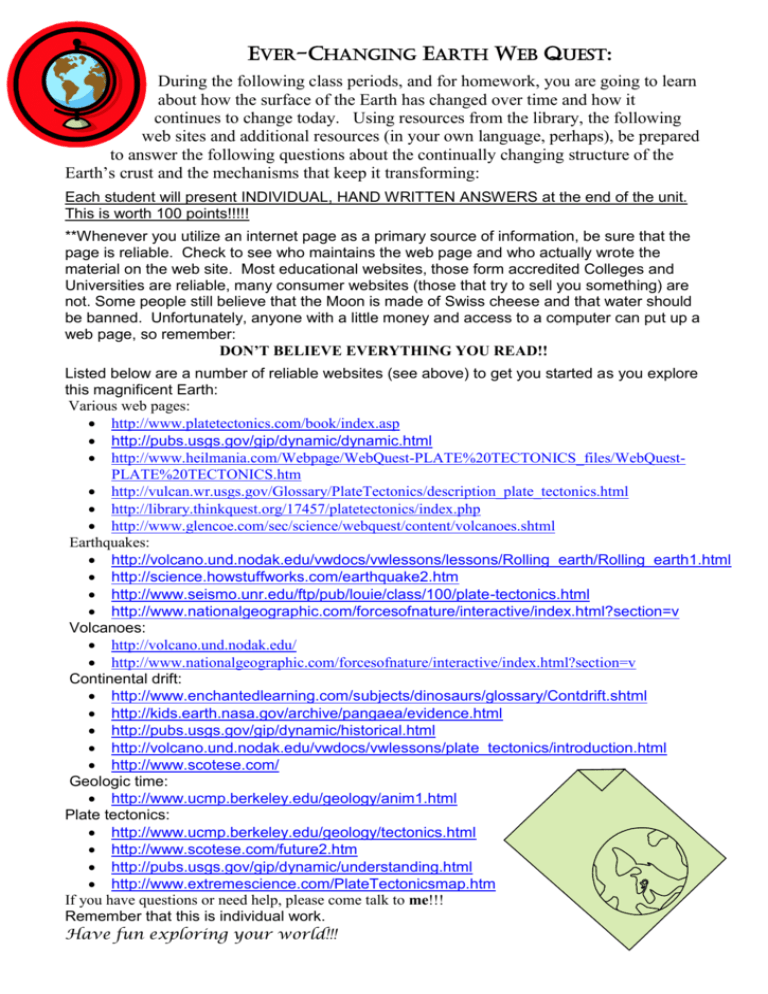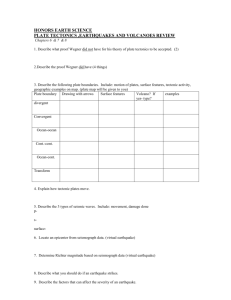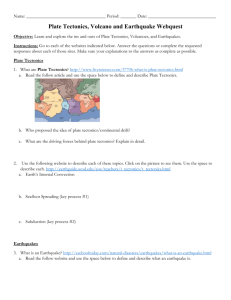EVER-CHANGING EARTH WEBQUEST:
advertisement

EVER-CHANGING EARTH WEB QUEST: During the following class periods, and for homework, you are going to learn about how the surface of the Earth has changed over time and how it continues to change today. Using resources from the library, the following web sites and additional resources (in your own language, perhaps), be prepared to answer the following questions about the continually changing structure of the Earth’s crust and the mechanisms that keep it transforming: Each student will present INDIVIDUAL, HAND WRITTEN ANSWERS at the end of the unit. This is worth 100 points!!!!! **Whenever you utilize an internet page as a primary source of information, be sure that the page is reliable. Check to see who maintains the web page and who actually wrote the material on the web site. Most educational websites, those form accredited Colleges and Universities are reliable, many consumer websites (those that try to sell you something) are not. Some people still believe that the Moon is made of Swiss cheese and that water should be banned. Unfortunately, anyone with a little money and access to a computer can put up a web page, so remember: DON’T BELIEVE EVERYTHING YOU READ!! Listed below are a number of reliable websites (see above) to get you started as you explore this magnificent Earth: Various web pages: http://www.platetectonics.com/book/index.asp http://pubs.usgs.gov/gip/dynamic/dynamic.html http://www.heilmania.com/Webpage/WebQuest-PLATE%20TECTONICS_files/WebQuestPLATE%20TECTONICS.htm http://vulcan.wr.usgs.gov/Glossary/PlateTectonics/description_plate_tectonics.html http://library.thinkquest.org/17457/platetectonics/index.php http://www.glencoe.com/sec/science/webquest/content/volcanoes.shtml Earthquakes: http://volcano.und.nodak.edu/vwdocs/vwlessons/lessons/Rolling_earth/Rolling_earth1.html http://science.howstuffworks.com/earthquake2.htm http://www.seismo.unr.edu/ftp/pub/louie/class/100/plate-tectonics.html http://www.nationalgeographic.com/forcesofnature/interactive/index.html?section=v Volcanoes: http://volcano.und.nodak.edu/ http://www.nationalgeographic.com/forcesofnature/interactive/index.html?section=v Continental drift: http://www.enchantedlearning.com/subjects/dinosaurs/glossary/Contdrift.shtml http://kids.earth.nasa.gov/archive/pangaea/evidence.html http://pubs.usgs.gov/gip/dynamic/historical.html http://volcano.und.nodak.edu/vwdocs/vwlessons/plate_tectonics/introduction.html http://www.scotese.com/ Geologic time: http://www.ucmp.berkeley.edu/geology/anim1.html Plate tectonics: http://www.ucmp.berkeley.edu/geology/tectonics.html http://www.scotese.com/future2.htm http://pubs.usgs.gov/gip/dynamic/understanding.html http://www.extremescience.com/PlateTectonicsmap.htm If you have questions or need help, please come talk to me!!! Remember that this is individual work. Have fun exploring your world!!! A. Earth’s Structure 1. What does the inside of the Earth look like? 2. How many major layers does it have? 3. What are these layers called? 4. How deep from the surface are they? 5. What are these layers made from (generally)? B. Geological time 6. What are the names of the geologic Periods? 7. When did they occur? 8. What major biological events are associated with each of these Periods? 9. Using an accurate scale of geologic time, if the creation of the Earth happened 1 year ago, how much time would have passes since the beginning of all of recorded history (about 5,000 years BCE) on this scale? C. Plate tectonics 10. What is a tectonic plate? 11. What are the names and locations of the Earth's plates? 12. What is a continent? 13. What relationship is there between a continent and a tectonic plate? 14. On the globe-projection map provided (the side with lines), please draw the names and locations of the plates and continents. Use a different color for each, if possible. 15. What was Pangaea? When was it formed? 16. What were Gondwanaland and Laurasia? When were they formed and what are they today? 17. What might the surface of the Earth look like in the future, hundreds of millions of years from now? 18. What famous scientist is most closely associated with the theory of continental drift? Where did he get this idea from? D. Plate boundaries 19. What are the three types of plate boundaries? 20. What are their characteristics? 21. Where would you find examples of each? 22. What generally happens when each of these types of boundaries move? 23. On the globe-projection map provided, please indicate where one of each type of plate boundary can be found. (Three boundaries total) E. The Ring of Fire 24. What is the "Ring of Fire"? 25. Where did it get that name? 26. On the world map provided (no lines), please draw the ring of fire in red. 27. How is the "Ring of Fire" associated with plate tectonics? (Hint: Refer to the map you made earlier) F. Earthquake 28. What causes earthquakes? 29. Where do they occur? 30. How are earthquakes detected? 31. How are they measured? 32. Is an 8.0 earthquake twice as destructive as a 4.0? 33. On the map provided, please draw where three major earthquakes have originated. Use a symbol for earthquake of your own choice. 34. How is an earthquake associated with plate tectonics? 35. What is an earthquake called in your own language? Does the name translate differently is you separate the word stems? G. Tsunami 36. What causes a tsunami? 37. Where do tsunamis occur? 38. How is a tsunami associated with plate tectonics? 39. What is a tsunami called in your own language? i. On the map provided, please draw where four major tsunamis have originated, including the nowinfamous one of December, 2004. Use a symbol for tsunami of your own choice. H. Volcano 40. What is a volcano? 41. Where are volcanoes found? 42. What are the different kinds of volcanoes? 43. What causes a volcano to erupt? 44. What is a volcano called in your own language? 45. On the map provided, please draw where 5 of the most active volcanoes can be found and name them. Use a symbol for the volcanoes of your own choice. I. Prevention 46. Can earthquakes, volcanoes and tsunami be predicted? 47. Describe the warning signs that occur before each of these events happen? 48. Can they be prevented? 49. What are the safety measures to be taken in case you are caught in one of these events? Grading for Earth Web Quest Project i. Your answers ii. Class notes iii. Sources iv. Map and key 50 10 10 30 1. plates and continents 2. boundaries 3. ring of fire Total 4. volcano 5. earthquake 6. tsunami /100






